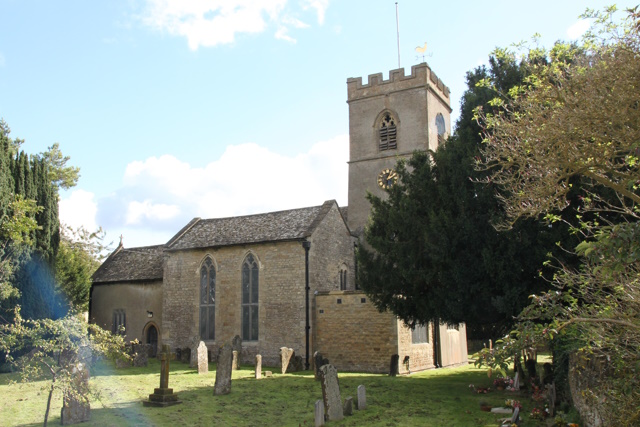


























St. James' Church, Stonesfield
St. James' Church in Stonesfield comprises chancel, aisled nave with north chapel, south porch, and a prominent western tower. Except for the north aisle and the south porch all were built or rebuilt in the 13th century, some of the work being of fine quality, notably the chancel arch, the south arcade of two bays, and windows in the north chapel. An 18th-century tradition that the earlier church was on the site of the north chapel and aisle, is not supported by architectural evidence. The age of the earlier north aisle is uncertain, but it was evidently in existence by the 14th century when the arch between it and the north chapel was built. Other 14th-century work included new windows in the chancel and the south aisle and an unusual treatment of the north window of the north chapel, where a square headed three-light window was placed outside a two-light 13th-century rear arch. In the 15th century the tower was heightened and an elaborate west window inserted in its lowest stage; the east window and the chapel roof are also 15th-century work. The insertion of a 15th-century carved oak screen in the rectangular opening between chancel and chapel may have followed a rebuilding of the dividing wall, which is oddly narrow and may have once contained an archway. The plain clerestory appears to be post-medieval and was perhaps added or refenestrated in the 17th century. In 1717 the church was said to be 'out of repair and in great danger', and was again in poor condition in the early 19th century. In 1807 George Spencer, duke of Marlborough, gave £150 for repairs and in 1814 a further £50 towards the cost of new pews, presumably replacing the enclosed pews which the church had contained since at least the 16th century. Also in 1814 the rector, Walter Brown, repaired the paving and the west end of the chancel. In 1825 the north aisle arcade was removed and the aisle enlarged to provide space for a gallery; some of the masonry of the former arcade was used to create a tall rectangular opening surmounted by a wooden beam. The aisle has been much criticized for destroying the small scale of the church. The gallery soon lost its popularity, and by 1872 it was decided to remove it. A restoration of 1876 probably included the removal of the gallery and of plaster ceilings of uncertain date in the nave and chancel, the insertion of tall windows in the north aisle, the restoration of the north chapel and the screen between chapel and chancel, and the rebuilding of the south porch and doorway. The former porch and doorway, described in 1846 as 'modern and very bad', probably dated from the early 19th century. There were several major repairs and restorations in the 20th century, including the restoration of the north chapel as a Lady chapel in 1933. In 1956 a vestry was built on to the west end of the north aisle. The church contains a 13th-century piscina in the south aisle and a 14th-century one in the chancel. The octagonal 14th-century font in the north aisle formerly stood at the south door. There is a carved oak pulpit dated 1629. The east window of the chancel contains some medieval stained glass, and there is 16th-century armorial glass in the south-west window of the chancel and in the clerestory; the glass represents families unconnected with Stonesfield and was placed there by Francis Robinson, who had inherited it from William Fletcher of Oxford, a collector. The plate includes a chalice of 1575, and there are six bells, of which one was given in 1783 after 'a large and liberal subscription of the young people of the parish'. Until c. 1925 the tower contained a single-handed clock, probably of the 17th century, reputedly brought to Stonesfield from a house in Woodstock in 1743. There are memorial inscriptions to several rectors, the earliest being Thomas Ashfield (d. 1704). The churchyard, which was extended several times from 1856, contains some notable 18th-century headstones. By 1613 the parish owned a house, close, and ½ a. of land whose income was for church repair. The church land increased to c. 8 a. and four cottages, and at inclosure in 1804 the land was exchanged for 6 a. The churchwardens usually granted short-term leases, but in 1807 the donation by the duke of Marlborough for church-repair was met by a 21-year lease of the church land. Income from the property was usually sufficient for the ordinary expenses without a church rate. In 1891 the church owned only two cottages, and they were sold in the 1950s; the land was still let in 1979. From 1882 the church choir benefited from the interest on £80 given by John Stewart. Historical information about St. James' Church is provided by British History Online. A P Baggs, Christina Colvin, H M Colvin, Janet Cooper, C J Day, Nesta Selwyn and A Tomkinson, 'Parishes: Stonesfield', in A History of the County of Oxford: Volume 11, Wootton Hundred (Northern Part), ed. Alan Crossley (London, 1983), pp. 181-194. British History Online http://www.british-history.ac.uk/vch/oxon/vol11/pp181-194 [accessed 24 April 2023]. St. James' Church is a Grade II* listed building. For more information about the listing see CHURCH OF ST JAMES THE GREAT, Stonesfield - 1053074 | Historic England. For more information about St. James' Church see Parishes: Stonesfield | British History Online (british-history.ac.uk). |

